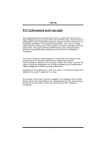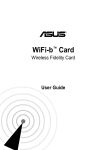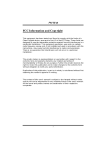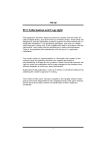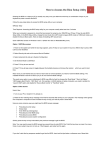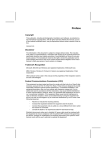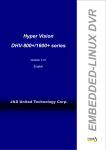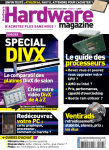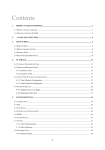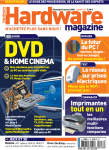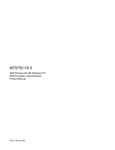Download Rose electronics MultiStation Instruction manual
Transcript
PC SHARING SYSTEM INSTALLATION AND OPERATIONS MANUAL 10707 Stancliff Road Houston, Texas 77099 Phone: (281) 933-7673 WWW.ROSE.COM LIMITED WARRANTY ® Rose Electronics warrants the MultiStation PC™ to be in good working order for one year from the date of purchase from Rose Electronics or an authorized dealer. Should this product fail to be in good working order at any time during this one-year warranty period, Rose Electronics will, at its option, repair or replace the Unit as set forth below. Repair parts and replacement units will be either reconditioned or new. All replaced parts become the property of Rose Electronics. This limited warranty does not include service to repair damage to the Unit resulting from accident, disaster, abuse, or unauthorized modification of the Unit, including static discharge and power surges. Limited Warranty service may be obtained by delivering this unit during the one-year warranty period to Rose Electronics or an authorized repair center providing a proof of purchase date. If this Unit is delivered by mail, you agree to insure the Unit or assume the risk of loss or damage in transit, to prepay shipping charges to the warranty service location, and to use the original shipping container or its equivalent. You must call for a return authorization number first. Under no circumstances will a unit be accepted without a return authorization number. Contact an authorized repair center or Rose Electronics for further information. ALL EXPRESS AND IMPLIED WARRANTIES FOR THIS PRODUCT INCLUDING THE WARRANTIES OF MERCHANTABILITY AND FITNESS FOR A PARTICULAR PURPOSE, ARE LIMITED IN DURATION TO A PERIOD OF ONE YEAR FROM THE DATE OF PURCHASE, AND NO WARRANTIES, WHETHER EXPRESS OR IMPLIED, WILL APPLY AFTER THIS PERIOD. SOME STATES DO NOT ALLOW LIMITATIONS ON HOW LONG AN IMPLIED WARRANTY LASTS, SO THE ABOVE LIMITATION MAY NOT APPLY TO YOU. IF THIS PRODUCT IS NOT IN GOOD WORKING ORDER AS WARRANTIED ABOVE, YOUR SOLE REMEDY SHALL BE REPLACEMENT OR REPAIR AS PROVIDED ABOVE. IN NO EVENT WILL ROSE ELECTRONICS BE LIABLE TO YOU FOR ANY DAMAGES INCLUDING ANY LOST PROFITS, LOST SAVINGS OR OTHER INCIDENTAL OR CONSEQUENTIAL DAMAGES ARISING OUT OF THE USE OF OR THE INABILITY TO USE SUCH PRODUCT, EVEN IF ROSE ELECTRONICS OR AN AUTHORIZED DEALER HAS BEEN ADVISED OF THE POSSIBILITY OF SUCH DAMAGES, OR FOR ANY CLAIM BY ANY OTHER PARTY. SOME STATES DO NOT ALLOW THE EXCLUSION OR LIMITATION OF INCIDENTAL OR CONSEQUENTIAL DAMAGES FOR CONSUMER PRODUCTS, SO THE ABOVE MAY NOT APPLY TO YOU. THIS WARRANTY GIVES YOU SPECIFIC LEGAL RIGHTS AND YOU MAY ALSO HAVE OTHER RIGHTS WHICH MAY VARY FROM STATE TO STATE. NOTE: This equipment has been tested and found to comply with the limits for a Class B digital device, pursuant to Part 15 of the FCC Rules. These limits are designed to provide reasonable protection against harmful interference when the equipment is operated in a commercial environment. This equipment generates, uses, and can radiate radio frequency energy and, if not installed and used in accordance with the instruction manual, may cause harmful interference to radio communications. Operation of this equipment in a residential area is likely to cause harmful interference in which case the user will be required to correct the interference at his own expense. IBM, AT, and PS/2 are trademarks of International Business Machines Corp. Microsoft and Microsoft Windows are registered trademarks of Microsoft Corp. Any other trademarks mentioned in this manual are acknowledged to be the property of the trademark owner. Copyright Rose Electronics 2004. All rights reserved. No part of this manual may be reproduced, stored in a retrieval system, or transcribed in any form or any means, electronic or mechanical, including photocopying and recording, without the prior written permission of Rose Electronics. Rose Electronics Part # MAN-MSPC Printed In the United States of America - Revision 1.8 FCC/IC STATEMENTS, EU DECLARATION OF CONFORMITY FEDERAL COMMUNICATIONS COMMISSION AND INDUSTRY CANADA RADIO-FREQUENCY INTERFERENCE STATEMENTS This equipment generates, uses and can radiate radio frequency energy and if not installed and used properly, that is in strict accordance with the manufacturer’s instructions may cause interference to radio communication. It has been tested and found to comply with the limits for a Class B digital device in accordance with the specifications of Part 15 of FCC rules, which are designed to provide reasonable protection against such interference when the equipment is operated in a commercial environment. Operation of this equipment in a residential area is likely to cause interference, in which case the user at his own expense will be required to take whatever measures may be necessary to correct the interference. Changes or modifications not expressly approved by the party responsible for compliance could void the user’s authority to operate the equipment. This digital apparatus does not exceed the Class B limits for radio noise emission from digital apparatus set out in the Radio Interference Regulation of Industry Canada. Le présent appareil numérique n’émet pas de bruits radioélectriques dépassant les limites applicables aux appareils numériques de la classe B prescrites dans le Règlement sur le brouillage radioélectrique publié par Industrie Canada. EUROPEAN UNION DECLARATION OF CONFORMITY ACCORDING TO COUNCIL DIRECTIVE 89/336EEC & 73/23EEC This equipment is in conformity with the protection requirements of the following Council Directives: The Declaration of Conformity is based upon compliance of the product with the following harmonized standards: EN55022: 1998 EN61000-4-5: 1995 EN55024: 1998 EN61000-4-6: 1996 EN61000-4-2: 1995 EN61000-4-11: 1994 EN61000-4-3: 1995 EN60950: 2000 EN61000-4-4: 1995 TABLE OF CONTENTS Contents Disclaimer .............................................................................................. 1 System introduction ............................................................................... 1 Features ............................................................................................ 2 Compatibility ..................................................................................... 3 Package contents ............................................................................. 3 Hardware................................................................................................ 4 Cables .................................................................................................... 5 Installation .............................................................................................. 6 Pre-installation requirements ............................................................ 6 Installing the PCI card....................................................................... 7 Installing the Remote user module ................................................... 8 Applying power ................................................................................. 8 Installing the software ....................................................................... 9 User Operation..................................................................................... 12 Service Information .............................................................................. 16 Maintenance and Repair................................................................. 16 Technical Support ........................................................................... 16 Safety ................................................................................................... 17 Figures Figure 1. Hardware ................................................................................ 4 Figure 2. PCI card.................................................................................. 7 Figure 3. Remote user module .............................................................. 8 Figure 5. Software license agreement ................................................... 9 Figure 6. User information ................................................................... 10 Figure 7. Destination folder.................................................................. 10 Figure 8. Installation successful........................................................... 11 Figure 9. Console window.................................................................... 12 Figure 10. Station Properties ............................................................... 13 Figure 11. Station options .................................................................... 13 Figure 12. Start/Stop window............................................................... 14 Figure 13. Test screen ......................................................................... 14 Figure 14. Broadcast message screen ................................................ 15 Figure 15. Message box ...................................................................... 15 Appendices Appendix A. General specifications ..................................................... 21 Appendix B. Parts and cables.............................................................. 22 INTRODUCTION Disclaimer While every precaution has been taken in the preparation of this manual, the manufacturer assumes no responsibility for errors or omissions. Neither does the manufacturer assume any liability for damages resulting from the use of the information contained herein. The manufacturer reserves the right to change the specifications, functions, or circuitry of the product without notice. The manufacturer cannot accept liability for damages due to misuse of the product or other circumstances outside the manufacturer’s control. The manufacturer will not be responsible for any loss, damage, or injury arising directly or indirectly from the use of this product. System introduction Thank you for choosing the Rose Electronics MultiStation PC. The MultiStation PC is the result of Rose Electronics commitment to providing state-of-the-art solutions for today’s demanding workplace. The MultiStation PC has proven to be a valuable investment for any business, home, or office that has a need to share a common computer between two or more users. The MultiStation PC system consists of a PCI card and the remote user module. The PCI card installs in an unused PCI slot in the computer being shared. The remote user module connects to a keyboard, monitor, and mouse. The PCI card and remote user module are connected together with industry standard CAT-5 shielded, solid core twisted-pair cable terminated with RJ45 connectors. Using the MultiStation PC to expand the use of a common computer has several advantages that make it convenient for the users. With the MultiStation PC you get all the benefits of a second computer without the expense of purchasing another computer. Each user can work independently on the same or different application. One user can be updating the company’s financials and another user developing a software application with no interference. Each user can have their own Windows desktop, and share peripheral devices like printers, plotters, and scanners. Users can share a common modem and both connect and surf the web or send and receive E-mail over a single phone or DSL line with a single Internet connection. In a network environment, both users can share the PC’s network adapter and connection. MULTISTATION PC INSTALLATION AND OPERATIONS MANUAL 1 Features With the MultiStation PC you get all the benefits of a second computer without the expense of purchasing another computer. Allows multiple users to use one computer at the same time. Video resolution up to 1280 x 1024 x 16 bit High Color at 60 Hz 1024 x 768 x 32 bit True Color at 75Hz 800 x 600 x 32 bit True Color at 85Hz g g g Each user can work independently on the same or different application with no interference. Each user can have their own Windows desktop Share peripheral devices like printers, plotters, and scanners. Users can share a common modem and connect to the Internet. They can surf the web or send and receive E-mail over a single phone or DSL line with a single Internet connection Locate the second user up to 50 feet away from the PC using standard STP CAT5 cable. In a network environment, all users can share the PC’s network adapter and connection. Saves equipment cost, software cost, peripherals, networking, and other hardware costs. Easy to install and maintain. g g g g g g g g 2 MULTISTATION PC INSTALLATION AND OPERATIONS MANUAL Compatibility Computers PC compatible running Microsoft Windows XP (SP1 & SP2) or 2000 (SP2) P III or higher computer, Athlon AMD, Intel Celeron, and Intel, 848P + Chipsets. Ram 256 MB Ram + 128 MB per additional user Monitors VGA to UXGA Keyboards PS/2 Mouse PS/2 Package contents The package contents consist of the following: n The MultiStation PC PCI card n Remote user module n MultiStation PC installation software (CD) n 15 feet of STP CAT5 cable n Installation and operations manual If the package contents are not correct, contact Rose Electronics or your reseller, so the problem can be quickly resolved. Rose Electronics web site Visit our web site at www.rose.com for MultiStation PC product software updates and additional information on other products that are designed for data center applications, classroom environments and other applications. About this manual This manual covers the installation and operation of the MultiStation PC model. Registration Register your copy for future updates by registering at: http://www.rose.com/htm/multistationpc-online-registration.htm MULTISTATION PC INSTALLATION AND OPERATIONS MANUAL 3 HARDWARE Hardware Front Remote user module Rear Remote user module PCI card Figure 1. Hardware Connectors: Front § MiniDin-6 § MiniDin-6 PS/2 keyboard PS/2 mouse Rear § RJ45 § HD15M CAT5 cable connection VGA monitor connection PCI card § RJ45 CAT5 cable connection § Dip Switch Configuration setting switches 4 MULTISTATION PC INSTALLATION AND OPERATIONS MANUAL Cables PC to Remote user module The PCI cards RJ45 connector is connected to the Remote user module with up to 15 feet of standard CAT5 STP “solid core” cable terminated with RJ45 connectors (included). Rose Electronics cable part number CAB-08STPnnn. The maximum length of CAT5 cable that should be used is 50 feet (optional). Local User Remote User Module MULTISTATION PC INSTALLATION AND OPERATIONS MANUAL 5 INSTALLATION Installation Please refer to the safety section first before proceeding with any installation or configuration of the MultiStation PC. Installation of the MultiStation PC is an addition to Microsoft Windows XP or Windows 2000 operating system and must be performed correctly. Due to the variations in computer systems, installation of the MultiStation PC on non-approved hardware may require assistance. (See Appendix C for tested hardware list) Please follow the instructions step by step to insure proper installation. Pre-installation requirements The MultiStation PC is designed for Microsoft 32-bit Windows operating systems based on Intel x86 hardware architecture. In order to install and use the software, your computer must meet the following system requirements: • • • • Intel Pentium III, Celeron, AMD Athlon 500 MHz or higher Intel 848P + chipsets 256MB RAM (512 MB RAM recommended) Windows 2000 service pack 2 or higher or Windows XP service pack 1 or higher The above configuration is for two concurrent users. To add another user you will need to add another 128 MB RAM for each additional user. Microsoft Windows XP or 2000 must be installed prior to installing MultiStation PC. See the troubleshooting section if problems occur. Installation of the MultiStation PC consists of the following four steps. Make sure that the computer is powered down and unplugged from the main electrical outlet. 1. Installing the MultiStation PC’s PCI card 2. Connecting a keyboard, monitor, and mouse to the remote user module and connecting it to the MultiStation PC’s PCI card with CAT5 cable 3. Applying power 4. Installing the software 6 MULTISTATION PC INSTALLATION AND OPERATIONS MANUAL Installing the PCI card Ground yourself to a grounded metal object before installing the PCI card 1. Remove the computer cover and locate an un-used PCI slot on the motherboard 2. Install the MultiStation PC PCI card in the PCI slot by firmly applying uniform pressure on the top of the card until it seats properly in the PCI slot 3. Secure the PCI card with the proper size screw 4. Replace the computer cover Figure 2. PCI card Note: The two dipswitches located on the MultiStation PC’s PCI card should initially be in the “OFF” position (Default shipped position). If the dipswitches are not in the “OFF” position, set them both to the “OFF” position before applying any power. DO NOT install additional cards and remote user modules at this time. Complete the installation for one and have one user fully operational before installing additional cards. MULTISTATION PC INSTALLATION AND OPERATIONS MANUAL 7 Installing the Remote user module (NOTE: Power to the computer should be off) Connect the remote keyboard, monitor, and mouse to the corresponding connectors on the remote user module. The local computer’s keyboard, monitor, mouse, and other cable connections such as a printer, scanner, or USB cables should already be connected to the corresponding ports on the computer. Remote User Station Figure 3. Remote user module Connect the CAT5 cable from the Remote user module’s RJ45 connector to the RJ45 connector on the MultiStation PC’s PCI card. Applying power Turn on both the local computer’s monitor and the remote video monitor and turn on the shared computer. Windows will automatically recognize the MultiStation PC PCI card as new hardware and will prompt you to install the appropriate driver. Continue installing the drivers and after they are installed, re-start the computer when the restart computer prompt displays. This will load the MultiStation PC’s driver. 8 MULTISTATION PC INSTALLATION AND OPERATIONS MANUAL Installing the software To install the MultiStation PC software, make sure all connections are secure and no applications are running. Login to Windows XP or 2000 with an account that has administrator privilege. Close any applications that might be running and insert the MultiStation PC CD. If the installation procedure does not start automatically, run the “Index.htm” program from the CD. From the "Index.htm" display, you can install the software, view the Quick Start Guide, the product datasheet, and this manual. Click on INSTALL and the Installation Wizard will start. This software is copyrighted and you must agree to the license agreement to install and use this software. Read the license agreement as shown in Figure 4. If you agree click on the “I agree" button, if not, click "Cancel". Figure 4. Software license agreement MULTISTATION PC INSTALLATION AND OPERATIONS MANUAL 9 Figure 5. User information Next, enter the requested User information as shown in Figure 5. Enter the user information and serial number. (Note: serial # is located on the installation CD) When all information has been entered, click "Next". Figure 6. Destination folder You can install the MultiStation PC software in the default folder name “C:\Program Files\MultistationPC\” or change it to a folder name of your choosing by clicking on the “Browse” button. (Figure 6) 10 MULTISTATION PC INSTALLATION AND OPERATIONS MANUAL Figure 7. Installation successful When the installation is complete, the final “Finish” screen will display. (Figure 7). Click on the “Finish” button and restart the computer to initialize and load the MultiStation PC software. MULTISTATION PC INSTALLATION AND OPERATIONS MANUAL 11 OPERATION User Operation When the shared computer is first booted, the boot-up sequence can be seen on the monitor connected to the computer. The monitor connected to the remote user module will remain blank until the computer fully boots up and the login screen displays. After the computer fully boots up, the monitor connected to the user module will change from a blank screen to a blue screen and then to its login screen. If the monitor remains blank or the boot-up sequence is visible only on the monitor connected to the remote user module, refer to troubleshooting section to correct the problem. Due to the many differences in motherboards, Bios, and system configurations, some configuration of the MultiStation PC’s PCI card or the system BIOS may be needed to correct the video problem. The MultiStation PC, once installed and configured if needed, allows two users to independently use a single computer. Each user can login to Windows XP or 2000 with their custom desktop, screen saver, and Icons. They can run the same application or a different one simultaneously with no apparent performance degradation. With the computer connected to a network, each user can connect to the network using a common network card and access network servers and printers. Each user can connect to the Internet using a common modem, phone or DSL line and one internet connection. Figure 8. Console window The MultiStation PC installation will place a Console Icon on the running task toolbar. Double click on this Icon to bring up the MultiStation PC settings (Figure 8 ). 12 MULTISTATION PC INSTALLATION AND OPERATIONS MANUAL OPERATION Figure 9. Station Properties Under “Local settings”, select “Stations” and double clicking on the station name to display the stations properties (Figure 9). The “Station” tab displays information about the selected station. Figure 10. Station options The ‘Option” tab (Figure 10) allows you to name the station, assign a Logon program, logon program folder, and automatically turn the station on when the system starts. MULTISTATION PC INSTALLATION AND OPERATIONS MANUAL 13 Figure 11. Start/Stop window The “Start/Stop” tab displays the station’s status and allows you to stop the station and shut down its windows desktop (Figure 11). Pressing the “Stop” button will stop the station. If the “Automatically turn station on when system starts” check box is not checked (refer to Figure 10), this button will display “Start” so you can start this station. Figure 12. Test screen The “Test” tab (Figure 12) verifies that the base unit, keyboard, and mouse are initialized and the station’s launch status. If any item is not initialized on start-up, the value for that item will be “No”. Check the item whose value is “No” and click on the “Reset” button. This will reinitialize the user module, keyboard, and mouse. The value should change from “No” to “Yes” for that item. 14 MULTISTATION PC INSTALLATION AND OPERATIONS MANUAL Figure 13. Broadcast message screen The “Broadcast” tab (Figure 13) is a feature that will broadcast a message to the other station. Type in your message in the message box and click “OK”. The text message will display on the other station in a pop-up message box (Figure 14). Figure 14. Message box MULTISTATION PC INSTALLATION AND OPERATIONS MANUAL 15 SERVICE and SUPPORT Service Information Maintenance and Repair This Unit does not contain any internal user-serviceable parts. In the event a Unit needs repair or maintenance, you must first obtain a Return Authorization (RA) number from Rose Electronics or an authorized repair center. This Return Authorization number must appear on the outside of the shipping container. See Limited Warranty for more information. When returning a Unit, it should be double-packed in the original container or equivalent, insured and shipped to: Rose Electronics Attn: RA__________ 10707 Stancliff Road Houston, Texas 77099 USA Technical Support If you are experiencing problems, or need assistance in setting up, configuring or operating your MultiStation PC, consult the appropriate sections of this manual. If, however, you require additional information or assistance, please contact the Rose Electronics Technical Support Department at: Phone: (281) 933-7673 E-Mail: [email protected] Web: www.rose.com Technical Support hours are from: 8:00 am to 6:00 pm CST (USA), Monday through Friday. Please report any malfunctions in the operation of this Unit or any discrepancies in this manual to the Rose Electronics Technical Support Department. 16 MULTISTATION PC INSTALLATION AND OPERATIONS MANUAL SAFETY Safety The MultiStation PC has been tested for conformance to safety regulations and requirements, and has been certified for international use. Like all electronic equipment, the MultiStation PC should be used with care. To protect yourself from possible injury and to minimize the risk of damage to the Unit, read and follow these safety instructions. n n n n n n n n n n Follow all instructions and warnings marked on this Unit. Except where explained in this manual, do not attempt to service this Unit yourself. Do not use this Unit near water. Assure that the placement of this Unit is on a stable surface. Provide proper ventilation and air circulation. Keep connection cables clear of obstructions that might cause damage to them. Use only power cords, power adapter and connection cables designed for this Unit. Keep objects that might damage this Unit and liquids that may spill, clear from this Unit. Liquids and foreign objects might come in contact with voltage points that could create a risk of fire or electrical shock. Do not use liquid or aerosol cleaners to clean this Unit. Always unplug this Unit from its electrical outlet before cleaning. Unplug this Unit refer servicing to a qualified service center if any of the following conditions occur: § The connection cables are damaged or frayed. § The Unit has been exposed to any liquids. § The Unit does not operate normally when all operating instructions have been followed. § The Unit has been dropped or the case has been damaged. § The Unit exhibits a distinct change in performance, indicating a need for service. MULTISTATION PC INSTALLATION AND OPERATIONS MANUAL 17 Safety and EMC Regulatory Statements Safety information Documentation reference symbol. If the product is marked with this symbol, refer to the product documentation to get more information about the product. WARNING A WARNING in the manual denotes a hazard that can cause injury or death. CAUTION A CAUTION in the manual denotes a hazard that can damage equipment. Do not proceed beyond a WARNING or CAUTION notice until you have understood the hazardous conditions and have taken appropriate steps. Grounding These are Safety Class I products and have protective earthing terminals. There must be an un-interruptible safety earth ground from the main power source to the product’s input wiring terminals, power cord, or supplied power cord set. Whenever it is likely that the protection has been impaired, disconnect the power cord until the ground has been restored. Servicing There are no user-serviceable parts inside these products. Only service-trained personnel must perform any servicing, maintenance, or repair. The user may adjust only items mentioned in this manual. 18 MULTISTATION PC INSTALLATION AND OPERATIONS MANUAL TROUBLESHOOTING Keyboard or mouse on remote user module does not work. Cable is loose; re-seat keyboard or mouse cable at the CPU and the remote user module and reset the keyboard and mouse (Refer to Figure 12) n Keyboard and mouse cables reversed. n Boot-up sequence appears on the Remote user module monitor only n The system BIOS is detecting the MultiStation PC graphic adapter as the main display adapter. To correct this problem there are two options, either the dipswitches located on the MultiStation PC’s PCI card need to be changed or the BIOS/CMOS settings need to be changed. OPTION 1 – Change dipswitch settings First verify that the two dipswitches located on the MultiStation PC’s PCI card are both in the “OFF” position. (Refer to Figure 1) If the dipswitches are not in the “OFF” position, shut down the computer, set both switches to “OFF” and restart the computer. If the boot-up sequence displays on the monitor connected directly to the PC, proceed with your installation. If not: n Repeat the process of powering down the computer, changing the dipswitch settings and restarting the computer for each of the settings until one of the settings resolves the problem. Settings are “ON”, “OFF” / “OFF”, “ON” / “ON”, “ON”. If this does not correct the problem set the dipswitches back to “OFF”, “OFF” and try Option 2A and/or Option 2B. n OFF/OFF OFF/ON ON/OFF ON/ON (Default) OPTION 2 – BIOS/CMOS settings for AGP video adapter n If the host display is AGP, verify that the BIOS setup shows the AGP adapter as the host adapter Following are several examples of BIOS setups for different PC’s. 1. Boot your system and enter the BIOS setup. Select “Integrated Peripherals” and press enter. Verify that the setting for “Init Display First” is correct. If the display adapter is AGP, this item should show “AGP”. MULTISTATION PC INSTALLATION AND OPERATIONS MANUAL 19 2. Select “BIOS Features Setup”, enter “VGA Boot from”, and select the option “AGP” 3. Select “Integrated Peripherals” and press enter. Select “Init Display First”, then select “Enabled”. 4. Select “PNP, PCI & ON-BOARD I/O” and then select the “Init Display First” option. OPTION 2B – PCI video adapter If your main computer uses a PCI video adapter and the video is only displaying on the remote user module’s monitor, power down your computer and remove the MultiStation PC’s PCI card and move your PCI video card to the slot that was occupied by the MultiStation PC’s PCI card. Do not install the MultiStation PC’s PCI card at this time. Reboot your system and Windows XP will recognize the new hardware and install it. Re-install the MultiStation PC’s PCI card in the slot that was previously occupied by the PCI video adapter and reboot the system. The boot-up sequence should now appear on the video monitor connected to the PC and not on the monitor connected to the remove user module. Installation of software causes conflicts with my resident programs If you experience installation conflicts with startup or resident applications, it would be advisable to un-install the MultiStation PC software, reboot, then disable these applications, reboot, and reinstall the MultiStation PC Software. Once your reinstall the MultiStation PC software and reboot your PC, enable the startup or resident applications you disabled and reboot again. NOTE: Consult your Operating systems manual or vendor for instruction on disabling/enabling your startup and resident programs applications. "Blue Screen" Page Fault Error Message Received after software install When the installation is completed, you will be prompted to re-boot your system. If you receive a blue screen "Page Fault Error Message" during the re-boot process, please call Rose Electronics Tech Support. It may be determined that your system board is not compatible with the MultiStation PC software. This may be correctable with a firmware change. 20 MULTISTATION PC INSTALLATION AND OPERATIONS MANUAL APPENDICES Appendix A. General specifications MultiStation PC PCI card Bus Interface PCI bus V2.1: 5V, 32bit, 33MHz Video Chip Trident 3D Image T9750 Graphics chip (2D/3D graphics accelerator chip) 4 MB of SGRAM Supports 1280 x 1024 x 16bit High Color at 60 Hz Supports 1024 x 768 x 32bit True Color at 85Hz Supports 800 x 600 x 32bit True Color at 85Hz Supports 640 x 480 x 32bit True Color at 85Hz Data Transfer Rate Up to 132MB/sec Cable Interface RJ45 jack (with standard Ethernet pin-out for cable connecting to Remote user module) Cable CAT-5 STP (Shielded Twisted Pairs) cable Distance 50 ft. (15.24m) maximum with optional cable Dimensions / weight 6.5" x 4" (16.5cm x 10.1cm) / 3 oz. (0.085 kg) Power 7W (1.4A, 5V – PCI card / remote user module) DIP Switch 1 x 4 switch DIP switch bank to accommodate different motherboard initialization event counts.(0,4,8,64 counts) Agency Approval USA: FCC - Class B - Europe: CE MultiStation PC remote user module Connectors Video – DB15F Keyboard – PS/2 (MiniDin6F) Mouse – PS/2 (MiniDin6F) Communication – RJ45 Indicators LED for system status / Buzzer for error detection Dimensions / weight 2.25" x 3.3" x .75" / 3 oz 5.7 x 8.5 x 1.9cm / 0.085kg Power Remote user module - 5W (From PCI card) Max power to keyboard – 1W (0.1A, 5V) Environmental Operating temp. 34° to 104°F (0° to 40° C) Storage temp. -40°F to 140°F (-40° to 60° C) Humidity - 20% to 90% non-condensing Approvals FCC Class B, CE MULTISTATION PC INSTALLATION AND OPERATIONS MANUAL 21 Appendix B. Parts and cables Part Number KVM-PC42M CAB-08STP015 Description MultiStation PC PCI card /Module CAT5 cable Appendix C. Tested hardware list Motherboard Manufacturer D865GBF/D865PERC D865PERL P4R800-VM P4PE-X AB-BH6 845G MAX PT880Neo NS-7008 Ver1 PA2013 M7NBA3 M7NCG Pro Ver1.1 K7VTA3 V.6 K7S5A Pro REV5 PT800CE-A Rev1 Dell Dimension 4600 Dell Dimension 4600 Dell Dimension 2400 Dell Dimension 2400 Dell Dimension 8300 Athlon AMD 761/VIA 686 b FIC AD11 3dfxVoodoo3 SIS 6326 Quad head 4 512 DDR 161 Intel Intel ASUS ASUS Abit MSI MSI FIC Biostar Biostar ECS ECS ECS P4 Celeron P4 Celeron Intel P4 AMD Athlon AMD 761/VIA 686 b FIC AD11 ATI Rage Pro 128 SIS 6326 Quad head 4 512 DDR 161 Athlon AMD 761/VIA 686 b FIC AD11 Geforce 2 MX Geforce 2 MX MX400 4 512 DDR 161 Athlon VIA VT 82C686B Gigabyte GA 7DX F3 SIS 300 analog + digital out SIS-6326 Quad head 4 512 DDR 158 ASUS P5P800 ASUS P4P800 SE ASUS P4P800-VM ASUS P4P800S-X ECS “848P-A V2.0” (848p Chipset Motherboard for Intel Socket ECS “865PE-A” i865PE Chipset Motherboard for Intel Socket 478 EPoX “EP-4PDA3I-3” i865PE Chipset Motherboard for Intel AMD 22 AMD AMD P4 P4 P4 P$ P4 MULTISTATION PC INSTALLATION AND OPERATIONS MANUAL 10707 Stancliff Road Houston, Texas 77099 Phone: (281) 933-7673 WWW.ROSE.COM




























